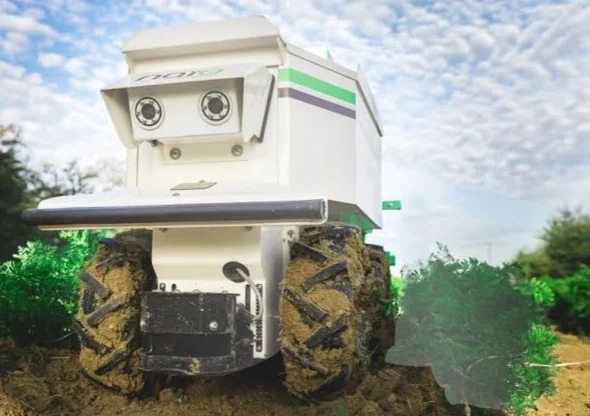American Fields Bloom with Innovation: Robotics Take Root in US Agriculture
The vast farmlands of the USA are undergoing a quiet revolution. Tractors are getting smarter, harvesters more precise, and fields are being monitored by buzzing drones. This agricultural transformation is driven by robotics, and it's poised to change the face of farming in America.
Statistics on Robotics in US Agriculture
| Statistic | Description | Source |
|---|---|---|
| Market Growth (Global) | Agricultural robots market to reach $23.4 billion by 2028 | Research on agricultural robotics market size |
| Labor Shortage (US) | Decline in agricultural workforce since 2000 | US Bureau of Labor Statistics agricultural jobs data |
| Precision Benefit | Up to 90% improvement in herbicide application accuracy | Purdue University study on ag robot herbicide application |
| Sustainability Impact | Potential 20% reduction in water usage through optimized irrigation | Environmental Protection Agency data on water usage in agriculture |
Fueled by Necessity
The rise of agricultural robotics stems from a confluence of factors. A growing global population demands increased food production, while the agricultural sector grapples with labor shortages. Traditional farming methods, often reliant on manual labor and imprecise techniques, struggle to meet these demands.
Robots to the Rescue
This is where agricultural robots, or "agbots," step in. These machines come in various shapes and sizes, each tackling specific tasks. Here are a few innovations driving the change:
- Automated Tractors and Harvesters: These high-tech machines use GPS and AI to navigate fields autonomously, reducing reliance on human labor and increasing efficiency.
- Weed-Wielding Robots: These nimble machines distinguish between crops and weeds, eliminating the need for chemical herbicides and promoting sustainable practices.
- Fruit-Picking Friends: From strawberries to apples, robots are being developed to delicately harvest fruits, minimizing damage and waste.
- Data-Driven Decisions: Drones equipped with sensors collect valuable data on crop health, soil conditions, and moisture levels. This information empowers farmers to make informed decisions about resource allocation and maximize yields.
Key Player Companies in US Agricultural Robotics
| Company | Area of Focus | Example Product/Service |
|---|---|---|
| Deere & Company | Autonomous tractors and implements | John Deere See & Spray Tractor |
| Blue River Technology | Selective weed control | See & Spray technology |
| Tevel Aerobotics | Autonomous fruit harvesting | Flying robots for apple harvesting |
| Abundant Robotics | Robotic harvesting for various crops | Strawberry harvesting robots |
| Yamaha Motor Corporation | Autonomous farm equipment | YA-G1 autonomous tractor |
| FarmWise | Data-driven weed control robots | Titan weeding robot |
Note: This table represents a small sampling of key players. The agricultural robotics industry is constantly evolving, with new companies and innovations emerging all the time.
A Sustainable Future
The benefits of robotics in agriculture extend beyond efficiency and productivity. Agbots can promote sustainable practices by minimizing water usage, reducing reliance on chemical pesticides, and promoting targeted resource allocation.
Challenges and Considerations
While the future of agriculture appears robotic, there are challenges to address. The upfront cost of these machines can be significant for small and medium-sized farms. Additionally, ensuring these technologies are accessible and user-friendly for all farmers is crucial.
Innovation on the Horizon
Despite the hurdles, the potential of robotics in US agriculture is undeniable. Research into swarm robotics, where multiple robots collaborate on tasks, and AI-powered automation hold immense promise for the future of American farms. As robotics continues to take root, US agriculture is poised for a period of increased productivity, sustainability, and innovation.
Frequently Asked Questions about Robotics in US Agriculture
Here are some common questions and answers about the growing trend of robotics in American agriculture:
General Questions
- What is the current state of robotics in US agriculture?
- Robotics is rapidly gaining traction in US agriculture, with companies developing a wide range of autonomous machines for various tasks.
- Why is there a growing interest in agricultural robotics?
- Several factors contribute to this interest, including labor shortages, rising costs, and the desire for increased efficiency and sustainability.
Technology and Features
- What types of robots are being used in US agriculture?
- Autonomous tractors, drones, and specialized machines for tasks like weeding and harvesting are becoming increasingly common.
- How do these robots work?
- They rely on a combination of GPS, sensors, and advanced algorithms to navigate fields, avoid obstacles, and perform tasks with precision.
Benefits and Applications
- What are the benefits of using robotics in agriculture?
- Robotics can improve efficiency, reduce labor costs, increase precision, and enhance sustainability.
- What are some specific applications of agricultural robotics?
- They are used for tasks like planting, weeding, harvesting, data collection, and monitoring crop health.
Challenges and Future Trends
- What are the challenges of implementing robotics in agriculture?
- Challenges include high costs, infrastructure limitations, regulatory hurdles, and the need for robust technology to withstand outdoor conditions.
- What are the future trends in agricultural robotics?
- Future trends include further integration with AI, IoT, and automation technologies. Robots could become more autonomous, capable of handling a wider range of tasks and adapting to changing conditions.
Note: For the most accurate and up-to-date information, it's recommended to research recent industry news or consult with experts in the field.

